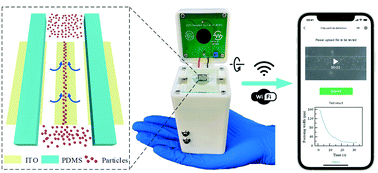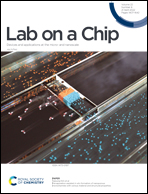A visual portable microfluidic experimental device with multiple electric field regulation functions†
Abstract
High portability and miniaturization are two of the most important objectives pursued by microfluidic methods. However, there remain many challenges for the design of portable and visual microfluidic devices (e.g., electrokinetic experiments) due to the use of a microscope and power supply. To this end, we report a visual portable microfluidic experimental device (PMED) with multiple electric field regulation functions, which can realize the electric field regulation functions of various basic microfluidic experiments through modular design. The internal reaction process of the microfluidic chip is displayed by a smartphone, and the experimental results are analyzed using a mobile phone application (APP). Taking the induced-charge electroosmosis (ICEO) particle focusing phenomenon as an example, we carried out detailed experiments on PMED and obtained conclusions consistent with numerical simulations. In addition to ICEO experiments, other functions such as alternating electroosmosis (ACEO), thermal buoyancy convection, and dielectrophoresis (DEP) can be realized by replacing module-specific covers. The device expands the application of microfluidic experiments and provides a certain reference for the further integration and portability of subsequent microfluidic experiment devices.

- This article is part of the themed collection: Miniaturised Sensors & Diagnostics


 Please wait while we load your content...
Please wait while we load your content...